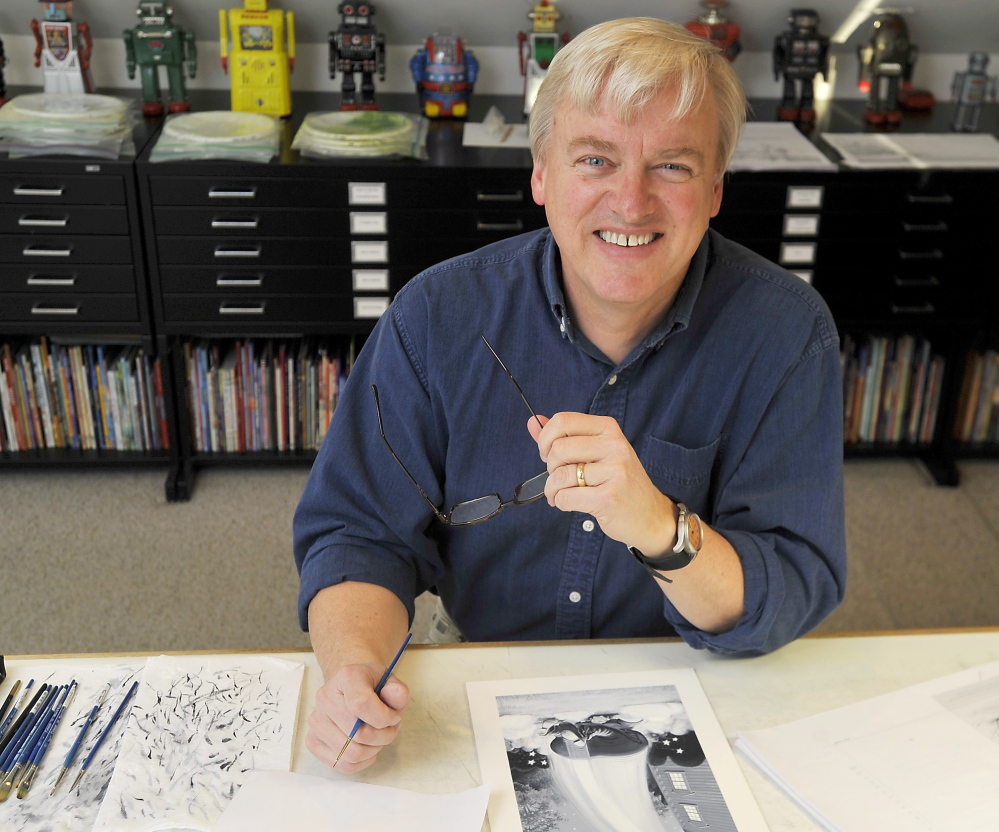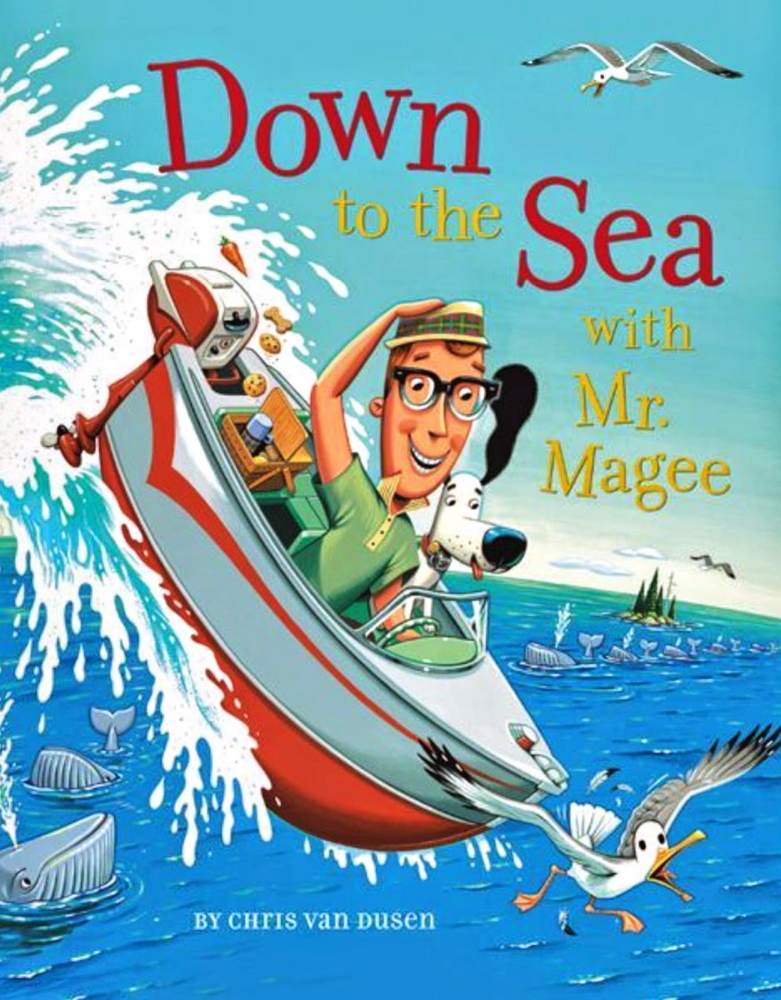From the time they’re very young, kids often demand to hear the same book over and over and over. Happily there’s one Mainer’s books that few parents will mind putting on repeat: Chris Van Dusen.
Reviewers have called his writing “adrenalizing” and his illustrations “stunning.” And, if you’ve read his books you know, depth and detail make his pictures pop off the page; his rhythmic, rollicking prose feels more like singing than reading.
Van Dusen keeps up a breathtaking pace. Since he published his first book in 2000, “Down to the Sea with Mr. Magee,” Van Dusen has written and illustrated seven other books. He has illustrated eight more books including the 2014 releases, “President Taft is Stuck in the Bath” by Mac Barnett and “Leroy Ninker Saddles Up” by Kate DiCamillo.
Van Dusen’s work has earned a raft of awards, starred Kirkus Reviews and critical praise from tastemakers like Publishers Weekly, The New York Times and The Wall Street Journal. His books have been Book-of-the-Month Club selections and have been given to thousands of Maine kindergartners through the Read with ME program.
The Portland native is not slowing down anytime soon. This fall, he and DiCamillo will release “Francine Poulet Meets the Ghost Raccoon.” Next Spring, “Hattie & Hudson,” which Van Dusen wrote and illustrated, will hit store shelves.
Van Dusen, 54 and a father of two, lives in Camden with his wife, Lori. He works from a home studio, surrounded by meticulously filed notes, sketches and prints, a library of his favorite children’s books, and a collection of toy robots, their retro designs evoking the 1960s of his childhood that flavor many of his works.
Van Dusen took time to talk with the Maine Sunday Telegram about his work.
Q: Which came first, writing or illustration?
A: I was an illustrator way before I ever attempted to write anything. I studied fine art at the University of Massachusetts at Dartmouth. I thought I would go on to get my master’s degree so I could teach art at a college level then take the summers off to paint. I had some shows in Portland that did well. But we had a young family, and I realized that in order to make it work, I needed to go the commercial route. I still use a lot of the things that I learned in art school, like the principles of composition, color, lines and figure drawing.
Q: What writers, illustrators and artists have inspired you?
A: In terms of writing, it’s Dr. Suess. As an illustrator, it would be Robert McCloskey. I’m a huge fan of Fairfield Porter, Edward Hopper, John Singer Sargent, Winslow Homer and Neil Welliver. I was lucky to meet (Welliver) at his studio in Lincolnville before he died (in 2005).
Q: How did you get into writing for children?
A: When I was freelancing, I did lots of different types of work. I worked for a greeting card company. I illustrated instructions for a company that made wooden swing sets, a poster for Ringling Brothers and Barnum & Bailey Circus, some L.L. Bean catalog covers, Down East magazine. And I designed the lobster license plate for the state of Maine. I ended up doing a lot of illustrations for kid’s magazines, like Disney Adventures, Nickelodeon and Family Fun. The more work I did, the more I realized that I liked doing things that were humorous, especially illustrations for kids.
Q: How did you start writing books?
A: For my first book, “Down to the Sea with Mr. Magee,” the image came first. I think in a visual way. One day, I was working and the image of a boat stuck in a treetop popped into my head. I sketched it out on a scrap of paper and went back to work. But I kept thinking about that illustration. I started wondering, “Why would a boat be stuck up in a tree?” And that was the start of the story. It was nine years between the time I did that first sketch and the time it was published. It got rejected by six different publishers before Chronicle Books picked it up.
Q: How did you learn how to write in rhyme?
A: Before “Down to the Sea with Mr. Magee,” I’d never written anything. But I always really liked Dr. Suess and the way his writing had such great rhythm and meter; it was almost like music. The story of Mr. Magee was so far-fetched that it just seemed like rhyme would match the fantasy and the whimsy of the story.
Before I started writing it, I went out and bought all the Dr. Suess books that I didn’t have. At night, my wife would be reading “Midnight in the Garden of Good and Evil,” and I’d be reading “Horton Hatches the Egg” with the same intensity. But it really did help as I was trying to get the words, musicality and rhythm just so. If rhyme is written well you almost don’t notice it. But if it’s off just a little bit, you just stumble over it. Sometimes something as minor as flip-flopping words will make a line flow better. When you find a way to make it work, you feel like you’ve really accomplished something. But you have to read it out loud and over and over to get it right. I also have other people read it to see if any lines trip them up. The first major award I received was the E.B. White Read Aloud Award for “If I Built a Car” (Dutton Children’s Books, 2005). That was such a thrill, because I really try to produce books that kids read again and again. I think that says a lot for a book.
Q: How have some of your other books been inspired?
A: I try to write books that I would have liked when I was a kid. I have a very strong memory of my childhood. I remember what I got for Christmas in 1966 and what fascinated me. I was inspired to write “If I Built a Car” because that’s what my brothers and I used to do on the long, tedious, family car trips we used to take. Of course we didn’t have all the distractions and screens that kids have nowadays, so we used to ask each other, “what would you do to make this car better?”
Also, I wanted to write a story using the formula that Dr. Seuss used in many of his books: A theme is presented on the first page then each spread after that plays off that theme but is almost a story within itself. In “If I Built a Car,” a boy dreams of building a car, then each spread describes a feature of the car. It all ends up back with the boy completing his dream.
For “The Circus Ship” (Candlewick Press, 2009), I had read an article in Down East about The Royal Tar, a circus ship that caught fire off the coast of Maine in 1836. It was illustrated with an old woodcut of the ship on fire. I stopped and read the story because in the corner of the woodcut illustration there was an elephant swimming out of the picture with its trunk held high. It was such an unusual thing to see. Then, after I read about the event, I was even more fascinated that it took place right here in Penobscot Bay. It literally hit home.
Q: How does Maine figure into your stories?
A: I’m inspired by the landscape around me, especially the midcoast region and all its beauty. So, even though it’s never mentioned (in the Mr. Magee books) that Mr. Magee lives in Maine, it certainly looks like the Camden and Rockport area. Readers can expect to see the Maine landscape in several of my books including the upcoming “Hattie & Hudson.”
Q: Tell me about “Hattie & Hudson.”
A: This is the first time I’ve written a non-rhyming story and the first time I’ve had a girl as a main character. Working on this book was a totally different process than writing the rhyming stories. I was used to the structure that rhyming creates, and without the rhyme, it felt very free form and wide open. It really made me appreciate really well-written stories much more.
Q: What advice would you give to an aspiring illustrator?
A: Before you do any kind of art work, whether it’s sculpture, painting or textiles, you have to have a good drawing base. You have to be adept at looking at something and being able to reproduce it in drawing. The better you get at drawing, the better you get at any type of artwork.
Jennifer Van Allen is a freelancer based in the Portland area. She can be reached through jenvanallen.com.
Send questions/comments to the editors.




Success. Please wait for the page to reload. If the page does not reload within 5 seconds, please refresh the page.
Enter your email and password to access comments.
Hi, to comment on stories you must . This profile is in addition to your subscription and website login.
Already have a commenting profile? .
Invalid username/password.
Please check your email to confirm and complete your registration.
Only subscribers are eligible to post comments. Please subscribe or login first for digital access. Here’s why.
Use the form below to reset your password. When you've submitted your account email, we will send an email with a reset code.